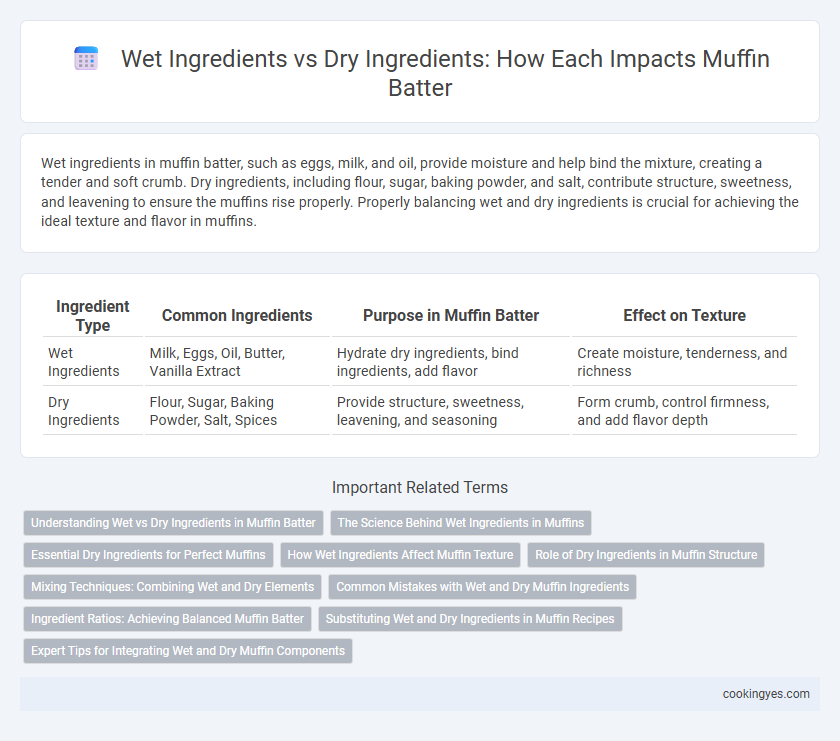Wet ingredients in muffin batter, such as eggs, milk, and oil, provide moisture and help bind the mixture, creating a tender and soft crumb. Dry ingredients, including flour, sugar, baking powder, and salt, contribute structure, sweetness, and leavening to ensure the muffins rise properly. Properly balancing wet and dry ingredients is crucial for achieving the ideal texture and flavor in muffins.
Table of Comparison
| Ingredient Type | Common Ingredients | Purpose in Muffin Batter | Effect on Texture |
|---|---|---|---|
| Wet Ingredients | Milk, Eggs, Oil, Butter, Vanilla Extract | Hydrate dry ingredients, bind ingredients, add flavor | Create moisture, tenderness, and richness |
| Dry Ingredients | Flour, Sugar, Baking Powder, Salt, Spices | Provide structure, sweetness, leavening, and seasoning | Form crumb, control firmness, and add flavor depth |
Understanding Wet vs Dry Ingredients in Muffin Batter
Wet ingredients in muffin batter typically include milk, eggs, oil, or melted butter, which provide moisture and aid in the leavening process, ensuring a tender crumb. Dry ingredients like flour, sugar, baking powder, salt, and sometimes spices contribute structure, flavor, and stability to the muffin. Properly balancing wet and dry components prevents overmixing, leading to a fluffy texture without toughness or sogginess.
The Science Behind Wet Ingredients in Muffins
Wet ingredients in muffin batter activate gluten development and help dissolve sugar, ensuring even sweetness and moisture distribution within the crumb. They also facilitate chemical reactions with leavening agents like baking powder or baking soda, producing carbon dioxide that creates the muffin's light, airy texture. Proper hydration from wet ingredients, including milk, eggs, and oil, impacts batter viscosity and ultimately determines the muffin's tenderness and rise.
Essential Dry Ingredients for Perfect Muffins
Essential dry ingredients for perfect muffin batter include all-purpose flour, baking powder, baking soda, sugar, and salt, which provide structure, leavening, sweetness, and flavor balance. Proper measurement and sifting of these dry components ensure an even distribution, preventing dense or tough muffins. Combining wet and dry ingredients just until moistened maintains the ideal muffin texture, avoiding overmixing that activates gluten development.
How Wet Ingredients Affect Muffin Texture
Wet ingredients in muffin batter, such as milk, eggs, and oil, directly influence the texture by hydrating the flour and activating gluten development. The amount and type of liquid determine moisture retention, resulting in either a tender or dense crumb. Proper balance ensures a moist, soft muffin with a light, airy structure.
Role of Dry Ingredients in Muffin Structure
Dry ingredients in muffin batter, such as flour, sugar, baking powder, and salt, provide the essential structure and texture by forming the gluten network and trapping air during baking. Flour supplies proteins that develop gluten, giving muffins their firmness and crumb, while chemical leaveners like baking powder create carbon dioxide for lift and lightness. Sugar not only adds sweetness but also contributes to moisture retention and browning, enhancing the muffin's overall appearance and mouthfeel.
Mixing Techniques: Combining Wet and Dry Elements
Proper muffin batter mixing involves gently folding wet ingredients into dry ingredients to avoid overdeveloping gluten, which can cause toughness. The wet ingredients, often including eggs, milk, and oil, must be combined just until moistened to maintain a tender crumb. Overmixing is the leading cause of dense or peaked muffins, so a light hand and quick folding technique ensure optimal texture and rise.
Common Mistakes with Wet and Dry Muffin Ingredients
Using incorrect ratios of wet to dry ingredients in muffin batter often causes dense or gummy texture, with excess liquid leading to overly wet muffins and insufficient liquid resulting in dry, crumbly crumbs. Common mistakes include overmixing wet and dry ingredients together, which develops gluten and toughens the muffin structure, and failing to properly measure flour by scooping instead of spooning, causing excess flour absorption. Ignoring ingredient temperature variations, such as using cold eggs or milk, can also affect batter consistency and final muffin rise.
Ingredient Ratios: Achieving Balanced Muffin Batter
Achieving balanced muffin batter requires precise ingredient ratios between wet and dry components. Typically, the ratio of dry to wet ingredients ranges around 2:1, ensuring the batter is thick enough to hold shape but moist enough to remain tender. Excess wet ingredients can create a runny batter and dense muffin, while too many dry ingredients result in a crumbly, dry texture.
Substituting Wet and Dry Ingredients in Muffin Recipes
Substituting wet and dry ingredients in muffin recipes requires careful balance to maintain the batter's consistency and texture. For wet ingredients, alternatives like applesauce, yogurt, or mashed bananas can replace oil or eggs to add moisture and binding properties. When altering dry ingredients, whole wheat flour or oat flour can substitute all-purpose flour, but adjustments in liquid quantities are often necessary to prevent dry or dense muffins.
Expert Tips for Integrating Wet and Dry Muffin Components
Expert tips for integrating wet and dry muffin ingredients emphasize combining dry components like flour, baking powder, and sugar separately from wet components such as eggs, milk, and oil to ensure proper texture. Gently fold the wet ingredients into the dry mix just until combined to avoid overmixing, which can cause tough, dense muffins. Incorporating wet and dry elements correctly maximizes moisture retention and creates a light, fluffy crumb.
Wet ingredients vs dry ingredients for muffin batter Infographic

 cookingyes.com
cookingyes.com